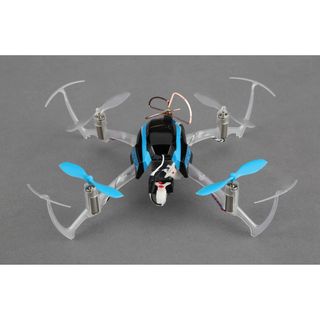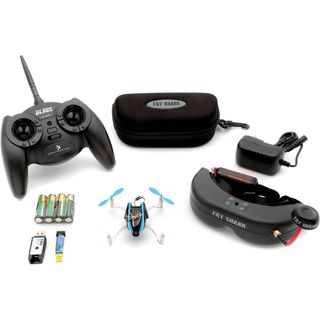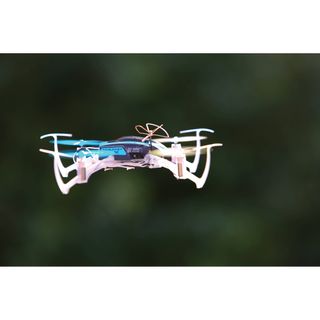Blade Nano QX RTF Quadcopter Review
The Blade Nano is a simple, easy-to-fly quadcopter that's a great pick for beginner or trainee pilots.
Why you can trust Tom's Guide

The Blade Nano QX RTF is a simple, easy-to-fly quadcopter that is a lot of fun. Designed to be flown indoors, this inexpensive drone is stable enough for beginners but nimble enough for stunt flying. Thanks to its tough construction and neat design, the Nano QX isn't likely to break things or itself when it crashes. While it doesn't crack our list of the best drones, Nano QX is a great pick for the first-time drone flier who wants to get a feel for the complex process of flying a quadcopter.
Design
The Blade Nano QX is an RTF ("ready to fly") quadcopter: To get it flying, all you need to do is charge and insert the battery. The quadcopter's design is simple, with a frame made from a single piece of plastic and a single printer circuit board. The canopy clips on top, and the battery fits securely beneath it. This frame is made of light plastic, but it is tough enough to withstand most crashes.

One very nice touch is the inclusion of prop guards — small pieces of plastic that extend from the frame beyond the four rotating propellers. If you fly sideways into something (as you inevitably will), these guards stop the fast-rotating propeller blades from hitting it, protecting both them and whatever you hit. They aren't foolproof, though: If the Nano QX flips over and hits something, the blades can still get caught. And the guards won't stop a curious person from sticking his fingers into the blades, either. While you won't lose a finger, such a maneuver will definitely cause the drone to crash.
The battery is a small, 150-mAh lithium-polymer pack that provides about 7 minutes of flying time. It's recharged with a USB-powered charger. We found that it took about 25 minutes to fully recharge. Swapping batteries is simple: Just disconnect the power cable, slide it out from the base of the quadcopter and reverse that to replace it.
Controller
The Nano QX uses a two-stick remote control, styled to resemble an Xbox controller. It fit nicely in my hand, with the sticks falling naturally under the thumbs. The aileron control (which tilts the drone left and right) is on the left stick, and the rudder (which rotates the drone left and right) is on the right. The throttle control (to ascend and descend) and elevator control (to move left and right) can be switched between the up-down of the two sticks, based on preference.

The throttle stick required very little force to move; in fact, I found it a little too easy to accidentally knock it and send the quadcopter spiraling away. Between these two sticks is a power switch that turns the controller on or off, as signaled by a single red LED. There are also buttons around the ring of the stick that allow you to trim the sticks to adjust their sensitivity. The remote uses four AA batteries.
Flying
The Nano QX is fun to fly. It can climb and turn quickly, zipping around at a decent speed, but the company doesn't offer any maximum claims. It reacted quickly to the controls, so quite precise flying is possible once you get used to the controls.
When you first connect the battery, the blue LED on the Nano QX blinks until you put it down on a flat surface. After it detects that it is on the ground and still, this LED turns solid blue, and you can kick on the throttle to take off. The Nano QX uses this same level detection, which it calls Sensor Assisted Flight Envelope (SAFE), to try to hover when you aren't touching the controls. It works well: The Nano QX will try to hover if you release the controls, but it won't save you if you take your eye off the quadcopter and let it zoom out of sight. SAFE can be disabled by pressing down the left stick, but it's best to leave it turned on unless you are an expert flier.
MORE: 100+ Tech Gift Ideas for Men, Women and Kids
The included remote control has a range of about 40 feet, which is adequate for a small quadcopter that's designed for indoor flying. The Nano QX has its downsides, though. While its light weight (just 0.58 ounces) does make it zippy and maneuverable, it also means that it is easily blown off course — even a slight breeze will send this ultralight quadcopter off course.
Repairability & Safety
It is inevitable that any drone will crash sooner or later, so it is important for it to be easy to repair. The Nano QX includes four spare rotor blades (the most frequently broken components) and a spare canopy, both of which are easy to swap out. This doesn't require tools; the rotors pull off the motors easily, and the canopy snaps simply into place. You can order other parts, but with a cheap quadcopter like this, buying a whole new quadcopter is easier in the event of a serious crash.

Battery Life
The Nano QX has a rather short battery life. We measured it at just under 7 minutes — a touch shorter than the 8 minutes the company claims. That's pretty typical for small drones like this; few can manage flight times in double digits. We measure the battery life of drones by testing how long they can maintain a steady, hovering position, so your flight time may be shorter if you are doing a lot of zooming.
The tiny 150-mAh battery doesn't last long, but spares are cheap; you can buy a pack of four for less than $20. These are recharged with the included USB adapter, which typically takes about 25 minutes to completely recharge a battery.
Bottom Line
The Nano QX is a fun little device that's a cinch to fly. The battery life is short, but spare batteries are cheap enough that you won't break the bank. In short, it is a great first quadcopter for the aspiring flier who wants to try one out before spending a fortune on an expensive drone, because it will teach the basics, and it's forgiving of the inevitable crashes.
Specs
Rotors: 4
Motor Type: 6 mm brushed cordless motors
Battery Size: 150 mAh litium ploymer (quadcoptor), 4AA (remote)
Battery Life: 7/8 minutes battery life (tested/claimed)
Size: 5.5 x 1.97 inches
Weight: 0.58 ounces flight weight
Sign up to get the BEST of Tom’s Guide direct to your inbox.
Upgrade your life with a daily dose of the biggest tech news, lifestyle hacks and our curated analysis. Be the first to know about cutting-edge gadgets and the hottest deals.
Richard Baguley has been working as a technology writer and journalist since 1993. As well as contributing to Tom's Guide, he writes for Cnet, T3, Wired and many other publications.
